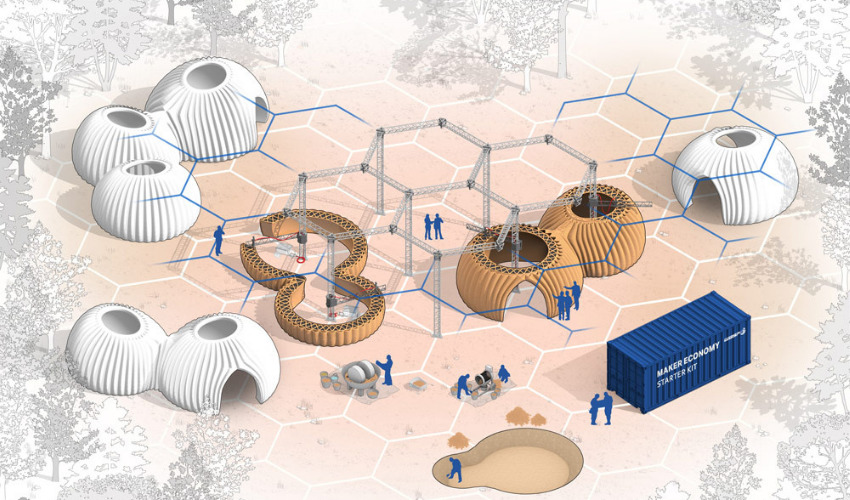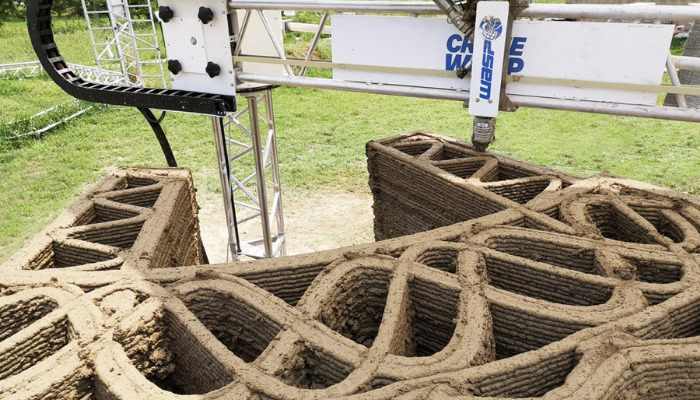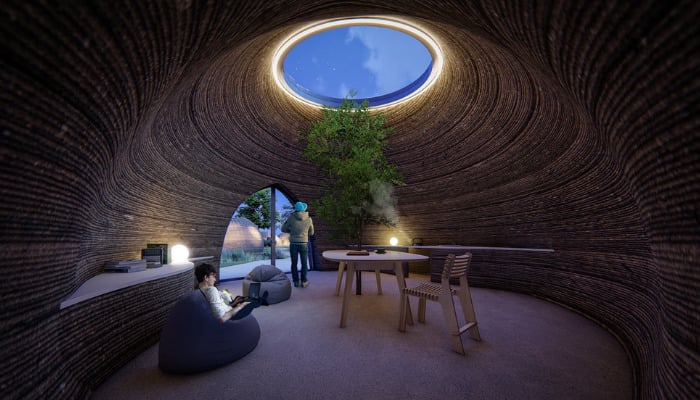WASP Talks Sustainable Housing and 3D Printing with Soil

Earlier this year, we talked about WASP (World’s Advanced Savings Project), an Italian 3D printing company who finished the printing phase of their TECLA supporting structure. TECLA, a 3D printed eco-habitat, was engineered by WASP and designed by Mario Cucinella Architects to help move to a more circular housing model, creating buildings out of recyclable materials taken from the local terrain. The project was built using the Crane WASP, WASP’s 3D printer in the construction sector and was considered to be a large step forward in the area of sustainable construction. Though 3D printing, especially in construction, is considered a more eco-friendly alternative to traditional methods, the use of unsustainable materials like concrete have made it controversial. Work like the TECLA eco-habitat could bring us closer to a world where both housing and ecological crises could be fully addressed through the medium of 3D printing. We sat down with Alberto Chiusoli, a Building Engineer and Computational Designer at WASP to learn more about the TECLA project, printing with soil and the current state of sustainable construction and 3D printed houses.
3DN: Could you introduce yourself and tell us more about WASP?
I’m Alberto Chiusoli, I have a degree in Building Engineering and Architecture from Alma Mater Studiorum, University of Bologna, Italy. I collaborated with Carlo Ratti Associati in Torino as a technical designer and also in London with ecoLogicStudio. Currently, I’m a member of WASP. Our challenge is to build, with sustainable materials, innovative architectural components. WASP – World’s Advanced Saving Project – is a company that was founded in 2012 in Massa Lombarda (Ravenna- Italy) that designs and produces 3D printers that are made in Italy and sells them all over the world. The wide range of WASP 3D printers has been developed to answer a variety of human needs: food, housing, health, energy, work, art and culture. Inspired by the potter wasp, which builds its own nest with material recovered from the surrounding environment, WASP was born with the aim of developing large-scale 3D printers, to build houses with natural materials and available in the territory, at zero cost to the environment. We aim to create healthy, low-impact houses that generate energy, food and wealth. In 2018 we built GAIA the first house entirely 3D printed using raw earth and waste from the agricultural supply chain. Recently, WASP rose to a new challenge. TECLA is a new eco-habitat, created using entirely reusable, recyclable materials taken from the local terrain. Built using Crane WASP – the latest innovation in on-site 3D printed construction – TECLA represents a step-change in the move towards eco-housing.

Alberto Chiusoli is a Building Engineer and Computational Designer at WASP.
3DN: Can you tell us more about your 3D printers for the construction market?
Crane WASP represents the latest technological advancement of WASP in the field of construction on the site, a system that has made possible the construction of the first housing module in raw earth, Gaia (2018). The Crane WASP 3D printing system has been developed in recent years of research with the aim of being an integral part of the Maker Economy Starter Kit project, a container intended for the transport of the main technologies necessary for the establishment of self-construction sites around the world through the opportunities presented by digital manufacturing. The Crane WASP 3D printer is mainly inspired by the construction crane model, with the integration of a sophisticated numerical control system, specifically developed for the 3D printing of building materials. Crane WASP represents a new way of conceiving the entirety of construction, from the construction phase to the installation phase. Right now the 3D printing construction market is progressing really fast but most of the players are focusing on concrete printing while we believe in the value of sustainability and technological progress for the good of humanity.
3DN: According to you, why is 3D printing a useful tool for sustainable construction?
3D printing, in its capacity as an advanced construction process, needs to control the chemical and physical parameters of the raw earth, monitoring the workability ranges in the printing process, the rheology of the mixture and the behavior once the material is laid. Digital design combined with 3D printing makes it possible to achieve high construction standards, high above the construction practices of pisè or adobe. The raw earth, once extruded, becomes an extremely sustainable building material both in terms of minimal environmental impact and architectural characteristics.

TECLA was 3D printed using multiple Crane WASP printers and soil
3DN: You recently created the TECLA eco-habitat and the material that you used for printing was soil. What are the challenges of using soil in 3D printing? How can its use become more mainstream?
At the base of the raw earth working process there is the extraction of the raw material, which is heterogeneous and depends on the mineralogical characteristics of the extraction soil. For this reason it is necessary to test the chemical and physical composition of the soil, with evaluations of the clay, silt and sand fractions and possible correction of the missing components. The sampling process is followed by a dry filtering phase of the soil, with the use of a rotating screen capable of eliminating the presence of stones larger than 9 mm, thus homogenizing the granulometry of the dry mixture and positively affecting the replicability of mixing operations. The latter is carried out through the use of the wet pan mill, a rotating mixing machine, with the addition of water, binding and stabilizing agents and natural fibers derived from the agricultural chain of rice (rice husks and straw). Mixing with a muller allows you to make a homogeneous and well-mixed mixture effectively and quickly. Once it is fully mixed, it is conveyed through continuous pumping systems to the extruder inlet with constant flow and pressure regulation through specific sensors. The deposition of the material therefore takes place through a helical screw that modulates the quantity of material and makes the laying homogeneous. The Crane WASP printer is included in the Maker Economy starter KIT and can be purchased and used all over the world. Our goal is to share knowledge and enable as many people as possible to have a home as a birthright.
3DN: How can we move to more sustainable structures? What is still needed?
Sustainable architecture is a cultural approach. Sustainable development, far from being a definitive condition of harmony, is a process of change such that the exploitation of resources, the direction of investments, the orientation of technological development and institutional changes must be made consistent with future needs beyond than with the current ones. Building’s increasing attention to the principles of environmental sustainability and the vision suggested by the 2030 Agenda for Sustainable Development is slowly but steadily changing the approach to design and construction. Investing in sustainable architecture means being far-sighted and aware that a life tailored to the man and the environment is possible only by protecting the common good, starting from our houses.

The TECLA eco-habitat is built using WASP 3D printers and local soil. Its design was inspired by the nests of the potter wasp.
3DN: Any last words for our readers?
For us who have been working on the project for many years, TECLA is the peak of advanced research between matter and technology, it is the achievement of an unparalleled challenge that has brought the printing geometry to its physical limit. The project represents an unprecedented perspective for buildings and new settlements, in which the value of local raw materials is amplified by digital design. The double dome solution made it possible to cover at the same time the roles of structure, roof and external cladding, making the house high-performance on all aspects. Now we are ready and we can really make the difference!
You can find out more about WASP and its projects at its website HERE. What do you think about 3D printing soil as a more sustainable construction method? Let us know in a comment below or on our Facebook, Twitter and LinkedIn pages! Sign up for our free weekly Newsletter here, the latest 3D printing news straight to your inbox!
All photo credits: WASP







Reading the technological description of the formation of the in-situ soil exrudate, there are a number of synthetic chemical/mineral additions to the base soil such as plasticisers , latex and silanes. At what point does a 3D in-situ soil build become a product of the commercial additives it contains? Can these commercial additives ultimately be synthesised from sustainable sources?
This article is great. I would like to know more about clay soil being used as a building material